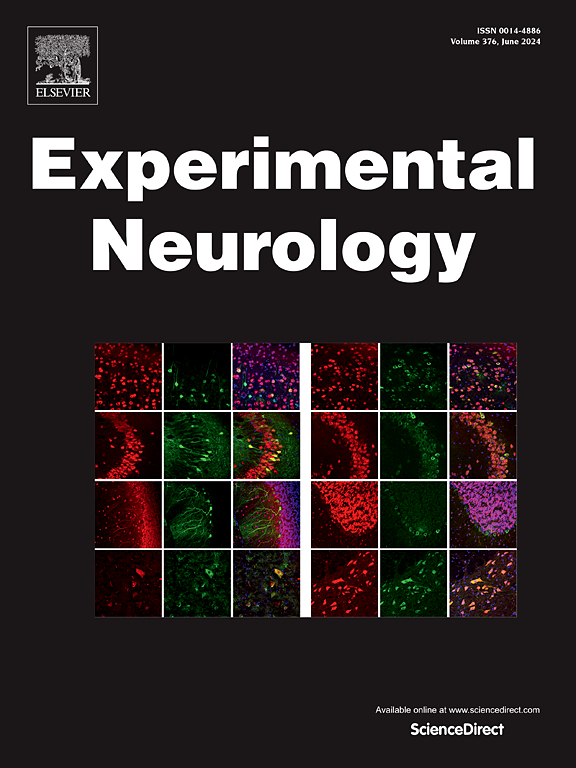Protective effects of Salidroside against ferroptosis through PPARG-dependent mechanism in diabetes-related cognitive impairment
IF 4.6
2区 医学
Q1 NEUROSCIENCES
引用次数: 0
Abstract
Objective
This study focused on investigating the benefits and potential mechanism of Sal in Leptin gene knockout mice (db/db) and primary hippocampal neurons.
Methods
In the current investigation, male db/db mice were administered Sal via oral gavage. Cognitive functions and learning and memory capacities were assessed through the Morris Water Maze (MWM) tests, respectively. Nissl, Fluoro-Jade C (FJC) staining techniques were employed to gauge hippocampal neuronal damage. Transmission electron microscopy facilitated the observation of mitochondrial alterations within hippocampal neurons of db/db mice. We further quantified Fe2+ levels, oxidative stress, and lipid peroxidation both in vivo & vitro. Western blotting got utilized to ascertain the relative levels of GPX4, PPARG, Nrf2 protein expressions.
Results
According to the study results, Sal supplement could dramatically relieve db/db mice’ cognitive impairment and protect neurons, through the inhibition of oxidative stress and the reduction of neuronal ferroptosis. According to further research, Sal could achieve a direct binding with peroxisome proliferator-activated receptor gamma (PPARG) for promoting it to be expressed. When culturing hippocampus-derived primary neurons, adding PPARG antagonist GW9662 or Nrf2 antagonist ML385 could eliminate the effect of Sal.
Conclusion
Taken together, the study is the first one that demonstrates the effectiveness of Sal in improving the cognitive impairment deficits of db/db mice as well as its inhibitory effect on oxidative stress and neuronal ferroptosis via PPARG-dependent mechanism.
红景天苷通过pparg依赖机制对糖尿病相关认知障碍的铁中毒的保护作用
目的探讨Sal对瘦素基因敲除小鼠(db/db)和海马原代神经元的作用及其潜在机制。方法本研究采用雄性db/db小鼠灌胃给予Sal。通过Morris水迷宫(Morris Water Maze, MWM)测试分别评估小鼠的认知功能和学习记忆能力。采用Nissl, Fluoro-Jade C (FJC)染色技术检测海马神经元损伤。透射电镜观察了db/db小鼠海马神经元线粒体的变化。我们进一步量化了体内和体内Fe2+水平、氧化应激和脂质过氧化。体外。Western blotting检测GPX4、PPARG、Nrf2蛋白的相对表达水平。结果研究结果表明,Sal补充剂可通过抑制氧化应激和减少神经元凋亡,显著减轻db/db小鼠认知功能障碍,保护神经元。根据进一步的研究,Sal可以与过氧化物酶体增殖物激活受体γ (PPARG)直接结合,促进其表达。在培养海马源性原代神经元时,加入PPARG拮抗剂GW9662或Nrf2拮抗剂ML385可消除Sal的影响。综上所述,本研究首次证实了Sal通过pparg依赖机制改善db/db小鼠认知功能障碍的有效性,以及对氧化应激和神经元铁凋亡的抑制作用。
本文章由计算机程序翻译,如有差异,请以英文原文为准。
求助全文
约1分钟内获得全文
求助全文
来源期刊

Experimental Neurology
医学-神经科学
CiteScore
10.10
自引率
3.80%
发文量
258
审稿时长
42 days
期刊介绍:
Experimental Neurology, a Journal of Neuroscience Research, publishes original research in neuroscience with a particular emphasis on novel findings in neural development, regeneration, plasticity and transplantation. The journal has focused on research concerning basic mechanisms underlying neurological disorders.
 求助内容:
求助内容: 应助结果提醒方式:
应助结果提醒方式:


